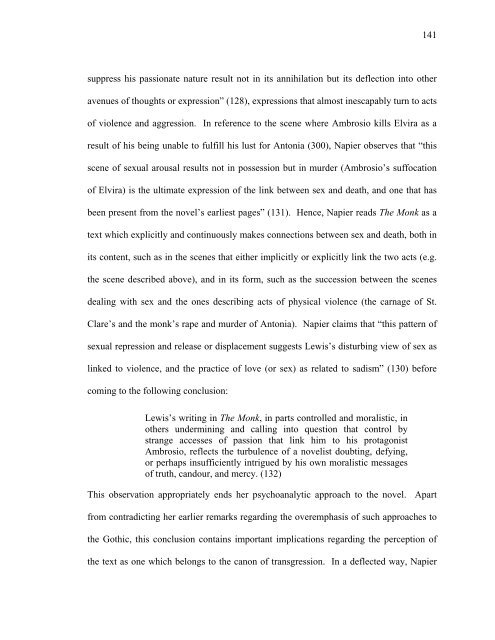Untitled - Sexey's School Moodle
Untitled - Sexey's School Moodle
Untitled - Sexey's School Moodle
You also want an ePaper? Increase the reach of your titles
YUMPU automatically turns print PDFs into web optimized ePapers that Google loves.
suppress his passionate nature result not in its annihilation but its deflection into other<br />
avenues of thoughts or expression” (128), expressions that almost inescapably turn to acts<br />
of violence and aggression. In reference to the scene where Ambrosio kills Elvira as a<br />
result of his being unable to fulfill his lust for Antonia (300), Napier observes that “this<br />
scene of sexual arousal results not in possession but in murder (Ambrosio’s suffocation<br />
of Elvira) is the ultimate expression of the link between sex and death, and one that has<br />
been present from the novel’s earliest pages” (131). Hence, Napier reads The Monk as a<br />
text which explicitly and continuously makes connections between sex and death, both in<br />
its content, such as in the scenes that either implicitly or explicitly link the two acts (e.g.<br />
the scene described above), and in its form, such as the succession between the scenes<br />
dealing with sex and the ones describing acts of physical violence (the carnage of St.<br />
Clare’s and the monk’s rape and murder of Antonia). Napier claims that “this pattern of<br />
sexual repression and release or displacement suggests Lewis’s disturbing view of sex as<br />
linked to violence, and the practice of love (or sex) as related to sadism” (130) before<br />
coming to the following conclusion:<br />
Lewis’s writing in The Monk, in parts controlled and moralistic, in<br />
others undermining and calling into question that control by<br />
strange accesses of passion that link him to his protagonist<br />
Ambrosio, reflects the turbulence of a novelist doubting, defying,<br />
or perhaps insufficiently intrigued by his own moralistic messages<br />
of truth, candour, and mercy. (132)<br />
This observation appropriately ends her psychoanalytic approach to the novel. Apart<br />
from contradicting her earlier remarks regarding the overemphasis of such approaches to<br />
the Gothic, this conclusion contains important implications regarding the perception of<br />
141<br />
the text as one which belongs to the canon of transgression. In a deflected way, Napier



